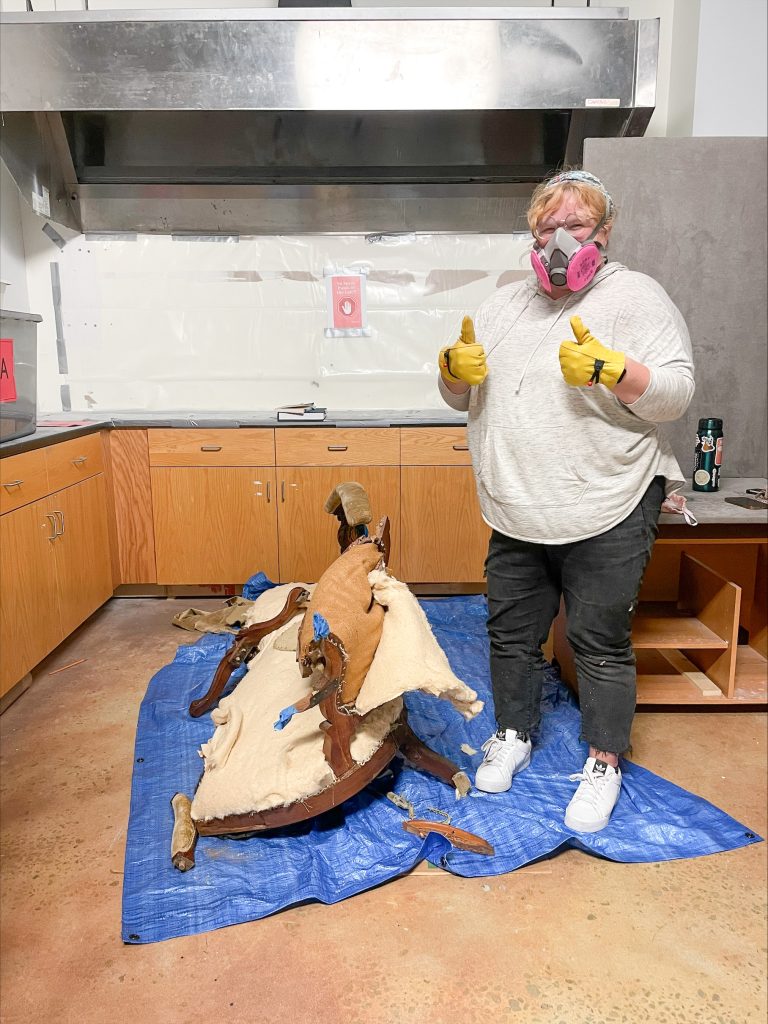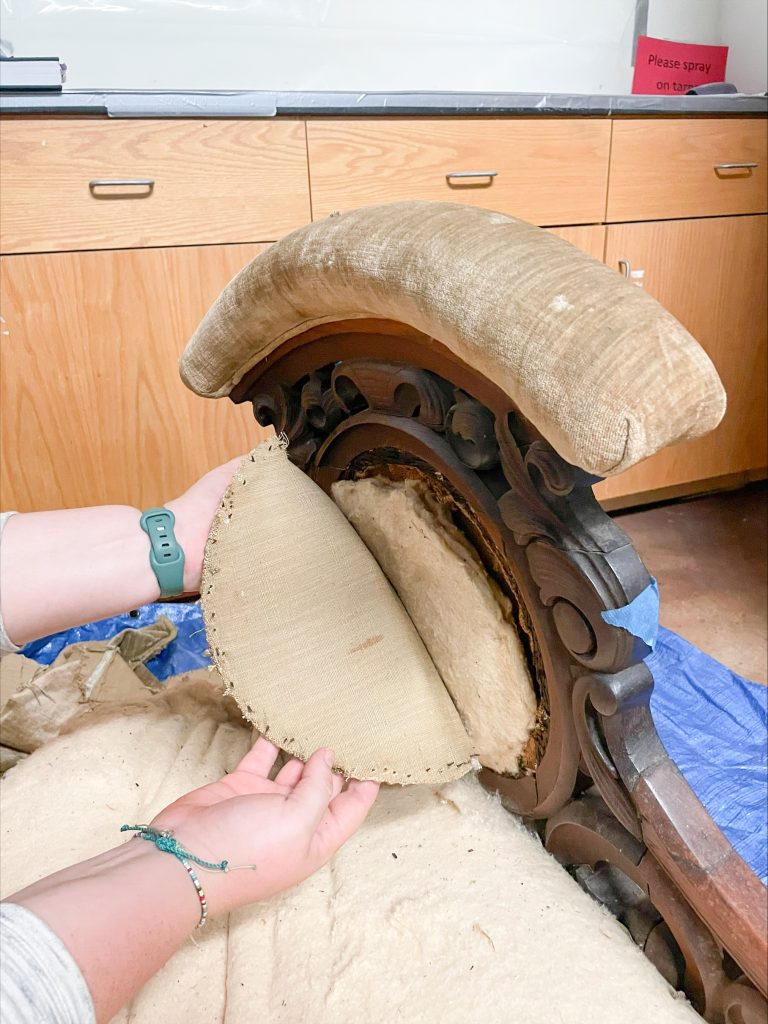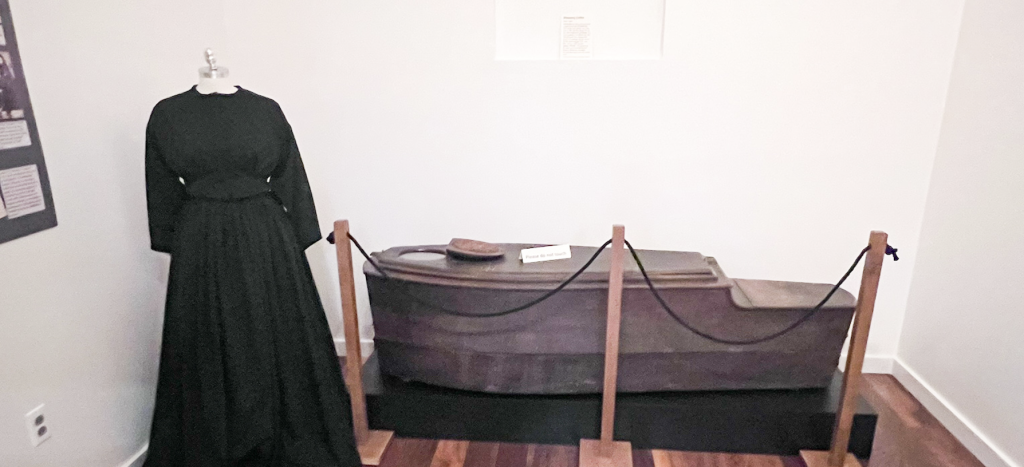Editors note: This post was updated by Maria Davis April 8, 2024
After receiving funds from a research grant in September 2023, Caitlyn Burnell and Sydney Cooper began refurbishing the settee in November and completed the restoration process in March.
Burnell explained that out of all the projects she has worked on in the past, refurbishing this historical settee was one of the most challenging projects to undertake because they had to “rebuild the whole thing.”
“We took (the settee) completely apart and put it back together,” Burnell said.
To ensure that the piece was fully restored to its original state, Cooper extensively analyzed the textiles of the Civil War era.
“(The refurbishing process) just tells you a story of how they lived. The settee itself is just very delicately carved wood. … There was lots of places that it had cracked, so we just basically had to form it and sand it and make sure we filled in those cracks perfectly so … that it looked fairly seamless,” Burnell said.
Although modern-day couches are used for leisure, Burnell explained that working on this settee helped her to have a new perspective on the Civil War era because it represented much more than just a piece of furniture.
Burnell said the settee was “something that was bought and made with such care” because it was used as an esteemed piece of décor back in the mid-19th century. Since the settee contained expensive materials like horsehair stuffing and authentic silk, Burnell felt that the piece would have belonged in an upper-class setting.
“(The refurbishing process) is a very interesting look into seeing how people actually lived their lives,” Burnell said.
The restored settee is currently on display at the Chaplains Museum in Miss Melanie’s Parlor. To find out more information, visit chaplainsmuseum.org.
Davis is the feature editor for the Liberty Champion
Preserving the past can come in many shapes and forms. The saving of historical pieces can provide learning opportunities and the ability to glimpse forgotten stories. Graduate interior design student, Sydney Cooper, and FACS (Family and Consumer Sciences) adjunct professor, Caitlyn Burnell, are using their skills for just this purpose as they restore a 19th century settee for Miss Melanie’s Parlor, an exhibit at the Chaplains Museum on campus.
According to Burnell and Cooper, the idea for this exhibit was already in the works under the guidance of Donna Donald, director of public history initiatives. Donald brainstormed the idea for the exhibit and brought it to Burnell and Cooper, who then did lengthy research on interior design during the Civil War period.
Miss Melanie’s Parlor serves as an interactive example of grieving and mourning during the Civil War era. The exhibit currently features a women’s mourning dress, shipping coffin and other Civil War artifacts. Now, the display will have the addition of an authentic Victorian era settee that was originally displayed in the historic Chase-Lloyd house in Annapolis, Maryland.

“(For people back then), they viewed (the grieving process) very different than we do,” Burnell stated. “To them, it was sacred.”
During her time in grad school, Burnell completed a project with the Chase-Lloyd House, where she was first offered the broken settee, which she had to decline given her living space and situation. However, when she began working on the Miss Melanie’s Parlor project with Cooper, she was able to reach back out to obtain the settee for the display.
The Chase-Lloyd House has a rich history to it. The three-story brick mansion was originally owned by Samuel Chase, a member of the Sons of Liberty. Chase eventually sold the still unfinished house to the aristocratic, plantation-owning Lloyd family. Edward Lloyd V, who was governor at the time, used the sprawling estate as his main residence.
“When slavery was abolished, the plantation was shut down and the house sat empty as (the Lloyds) house in town,” Burnell said.
Eventually, Hester Chase, a woman made rich through smart investments as well as being Samuel Chase’s niece, was able to purchase the home. She lived there with three adopted nieces.
In regard to refurbishing the settee, Burnell and Cooper recently received approval for the Center for Research and
Scholarship grant.

“There was a lot of research on the interiors, textiles and all the cultures of how people were living in this time and how that affected their houses,” Cooper said. “The process of it is just a lot of research, a lot of figuring out materials that we need and their specifications and measurements.”
Part of their process was figuring out the different types of materials used in furniture and clothing to better understand the makings of the antique settee. They also burned fabrics to dissect what materials the fabrics included depending on how they burned or what odor they emitted. They concluded that this piece of furniture was from the early Victorian era through the fact that the settee was stuffed with horsehair.
To see the settee when the project is finished, or to see exhibits like Miss Melanie’s Parlor, visit the Chaplains Museum on the terrace level of the Jerry Falwell Library. For more information, visit the museum’s website
Pickard is a feature reporter for the Liberty Champion.

Sue Gladd
September 1, 2023
The chaplain’s museum was a worthy endeavor to start with, and to add such an authentic piece of furniture restored according to its history is certainly a sweet addition…with more to come?